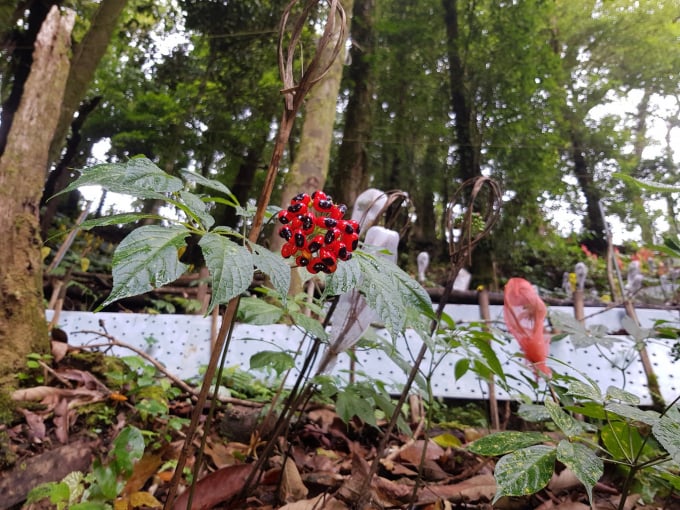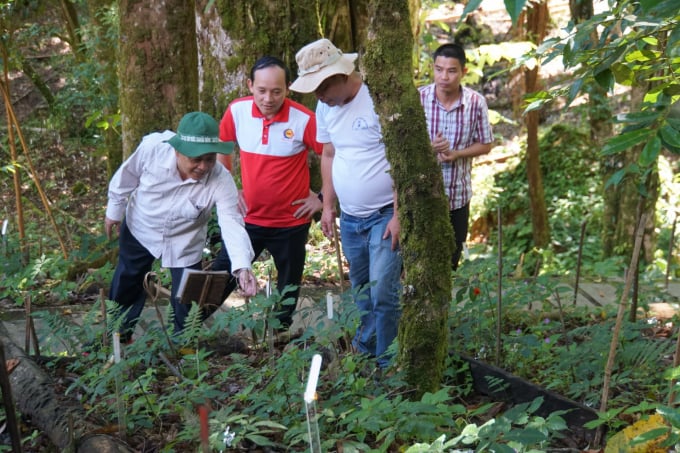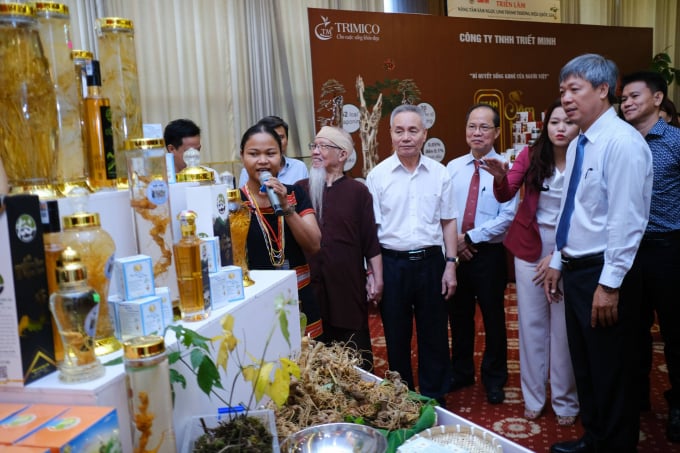November 21, 2025 | 22:05 GMT +7
November 21, 2025 | 22:05 GMT +7
Hotline: 0913.378.918
November 21, 2025 | 22:05 GMT +7
Hotline: 0913.378.918

Ngoc Linh ginseng is a precious medicinal plant distributed mainly in Ngoc Linh mountain range. Photo: L.K.
Ngoc Linh ginseng (Panax vietnamensis) is a rare medicinal plant distributed mainly in the Ngoc Linh mountain range. The plant is commonly seen in the two provinces of Kon Tum and Quang Nam. Having high economic value, in recent years the two localities have proposed various mechanisms and policies to preserve and develop this precious ginseng.
According to Mr. Tran Ut, Deputy Director of Quang Nam Department of Agriculture and Rural Development, the province has 15,576 ha planned for conservation and development of Ngoc Linh ginseng, and the area used for production exceeds 1,000 ha. The whole province has 20 businesses, households and individuals leasing over 1,600 ha of forest to grow Ngoc Linh ginseng. The province is also carrying out the migration of this plant to other mountainous districts.
And since Ngoc Linh ginseng has been invested in production development, the income of people in the region has remarkably increased, positively contributing to the process of hunger and poverty eradication in localities.
As for Kon Tum province, a specialized cultivation area to develop Ngoc Linh ginseng has been planned with a total area of nearly 32,000 ha. Kon Tum has more than 1,165 households, 30 household groups and production association groups, and 5 large enterprises participated in planting and developing Ngoc Linh ginseng with a total planted area of more than 1,240 ha. The total output of fresh ginsengs is estimated at 213 tons.

Many businesses have recently invested in planting Ngoc Linh ginseng and processing products from it. Photo: L.K.
Although the conservation and development of Ngoc Linh ginseng over the past time has made positive progress, both Kon Tum and Quang Nam provinces are still believed to encounter many shortcomings and limitations in the process of promoting the existing advantages.
Ngoc Linh ginseng’s production and sales management have to face some setbacks because of the situation of seeds and seedlings of unknown origin being sold. Forged Ngoc Linh ginseng products are rampant in the market, affecting general production as well as the genetic resources of original varieties. Consumers also suffer certain economic losses, thus greatly affecting the Ngoc Linh ginseng brand.
“The procedures, standards, variety quality assessment and the cultivation and development of Ngoc Linh ginseng do not have specific regulations to serve as a basis for organizing implementation in a methodical and unified manner to achieve high efficiency. The research and deep processing of products derived from Ngoc Linh Ginseng, especially in the medical field, has not been paid enough attention,” said Deputy Director of Kon Tum Department of Agriculture and Rural Development Huynh Van Liem.
To further enhance Ngoc Linh ginseng’s value and brand image, the two provinces have made recommendations to the ministries, branches as well as the Government. They propose the Prime Minister pay attention to soon promulgate the 2022-2030 Vietnamese Ginseng Development Program - orientation to 2045 and the Scheme "Pilot leasing forest environment for cultivation and development of medicinal plants.”

Compared to countries in the world such as the USA, Korea, Japan, China, products processed from Ngoc Linh ginseng of Vietnam are very few on the market at the moment. Photo: L.K.
The overall goal of the program is to develop Ngoc Linh ginseng into a commodity with high economic value, branded as a national product while being associated with sustainable use of forest resources and income increase for people.
In addition to preserving genes, developing material areas, investing in infrastructure, the program also pays special attention to raising the brand name and developing the market for Ngoc Linh ginseng. Establishments and factories for preliminary processing and deep processing will be formed along the raw material areas to create sustainable production link chains. The program will develop 80-100 highly competitive product lines bearing national brands while strengthening publicity and trade promotion at home and abroad.
According to President Nguyen Xuan Phuc, Ngoc Linh ginseng is Vietnam's new hope in the pharmaceutical and functional food industry, fiercely competing with advanced countries such as Japan, Korea, the USA, Japan and even China. “This is an opportunity to affirm our national pride, but it’s a feat we have yet to accomplish. We completely have the foundation to develop the Ngoc Linh ginseng growing and processing industries while aiming for the billion-dollar goal. Therefore, there is still a lot of work to be done which requires serious and methodical implementation."
Translated by Samuel Pham

(VAN) Results from the Sustainable Durian Model Project in Dak Lak have confirmed the critical role of Yara Viet Nam in transferring advanced nutritional solutions to farmers.

(VAN) In Tuyen Quang province, livestock farmers have introduced effective models and innovative practices that significantly strengthen African Swine Fever prevention and control efforts.

(VAN) This is the study conducted by IRRI and Can Tho University on the rice straw value chain in Mekong Delta showing an economic potential of more than 6.6 trillion VND/year.

(VAN) By participating in cooperative economics, many farmers in Tay Ninh have overcome hardship, mastered clean dragon fruit cultivation techniques.

(VAN) The crossbreeding program in the former Binh Dinh province (now part of Gia Lai) has shown signs of decline, and urgent measures are needed to revive it and sustain past achievements.

(VAN) The agricultural sector agreed on a roadmap to pilot the MRV protocol and expand low-emission rice production from the 2025-2026 winter-spring crop.

(VAN) Agricultural extension officers in Quang Ninh do more than transmit knowledge; they have become a steadfast support system for farmers on the path to sustainable agricultural development.